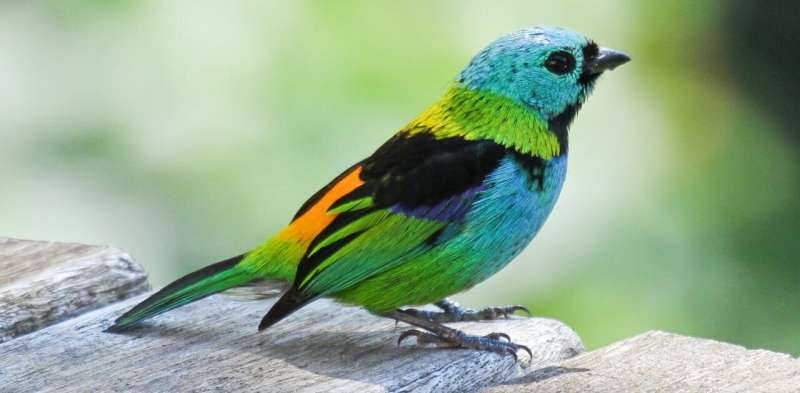Here's how we proved that tropical birds are more colourful—and why colour helps them survive

For many of us, the tropics conjure up thoughts of lush vegetation teaming with vibrant and strikingly colourful birds, insects and other creatures.
It's been a widespread belief that the tropical regions of the world are home to the most colourful species—an idea that probably dates back to the 19th century when famous naturalists, including Charles Darwin, remarked on the "rich variety of colours" found in the tropics compared to their high-latitude homelands.
And yet, until now, conclusive evidence for this geographical pattern in species colourfulness has been elusive.
One earlier study found that the tropical birds of South America were more colourful than those in North America, with European birds the least colourful. But other studies, such as one looking at birds along the east coast of Australia, found it was the species living in the arid regions—and not nearest the equator—who had the the most intense plumage colour.
So the issue has remained unresolved.
In our new research, published in the journal Nature Ecology & Evolution, we've finally discovered that the trend does seem to be true—tropical species of songbirds are indeed more colourful than their non-tropical counterparts, just as Darwin suggested.
And we think that it might be partly because of a need to stand out in the crowd, due to the higher concentration of different species living together in tropical communities.
Studying 4,500 songbird species
Using the global bird specimen collection at the UK's Natural History Museum we digitally photographed adult male and female specimens of more than 4,500 species of songbird from all over the world—ranging from the tropical Paradise Tanager (Tangara chilensis) to the higher latitude Brown Dipper (Cinclus pallasii).
We chose the songbirds (also known as the passerines) as they represent around 60% of all bird species and are therefore well represented in museum collections.
A cutting-edge computer technology called "Deep Learning"—which is able to learn to how to process and classify large amounts of complex data from images—helped us to extract information from the thousands of pixels in each photograph.
We were then able to measure the shade and intensity of plumage colours in each photo in terms of red, green and blue light, as well as ultraviolet—this was important as birds have a broader range of vision than humans and can perceive colours in the ultraviolet light spectrum.
Using this information we generated an accurate estimate of colourfulness of each species, based on the number of distinct colours (or "colour loci") in the plumage of each individual bird.
When we mapped variation in species' colourfulness scores across the globe, we found strong evidence that bird colourfulness is generally highest at the Equator and decreases with increasing latitude towards the poles—specifically, their plumages displayed around 20%-30% more colours than birds living at higher latitudes outside of the tropics, whether north or south.
Interestingly, this was true for both male and female birds, even though they can sometimes look very different from one another.
So, we'd proved Darwin's observations correct—the next step was to investigate which factors might cause this colour gradient.
The advantage of colour
There were a number of possible theories.
Perhaps the more favourable climate near the Equator—in terms of temperature and rainfall, for example—allowed tropical species to invest more energy in developing elaborate plumage colouration. Or maybe the influence of ecological factors, such as the amount of light in their habitat, could influence the birds' appearance.
To test these hypotheses, we collected information on the environmental and ecological characteristics of the species in our study, and used data analysis to find out with variables could help explain the variation in colourfulness across species.
We found that colour diversity was highest in birds from dense, closed forest habitats such as rainforests, and also in those who eat fruits and floral nectar.
Both of those traits are more common at tropical latitudes—so this suggests that two possible reasons for the evolution of colour diversity might be the need for brightly coloured visual communication (such as gestures and body postures) in dark tropical forests, and the ability to acquire colour-forming compounds (like carotenoids) from fruit in their diet.
And there was also a positive association between colourfulness and the diversity of the bird communities.
The average number of songbird species living together in the same location increases dramatically towards the Equator, so this enhanced colourfulness may help them to distinguish themselves from all the other birds in their rich tropical communities—a necessary skill to avoid potentially costly interactions with other species, which could even include mating.
Going forward, pinpointing the location of global colourfulness "hotspots", in different regions and among different species, will help us to plan effective species and habitat conservation strategies which preserve colour diversity.
As Alfred Russel Wallace, a 19th century British naturalist, once said: "There is probably no one quality of natural objects from which we derive so much pure and intellectual enjoyment as from their colours". We owe it to future generations to ensure the spectacular colourfulness of the natural world remains undiminished.
Provided by The Conversation
This article is republished from The Conversation under a Creative Commons license. Read the original article.![]()





















